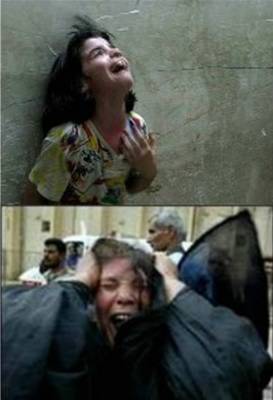"The targeting of tunnels by Israeli airstrikes has restricted the flow of food and fuel into Gaza. Few shops remain open and the UN has warned of an impending water crisis. There are reports of bombing campaigns purposely targeting irrigation wells. The Ministry of Health in Gaza is out of 40 per cent of essential medicines and running low on basics like bandages and syringes.
Gaza's dire situation began in 1948 when Zionist militia groups expelled over 700,000 Palestinians from their land, 200,000 of whom fled to Gaza and tripled its population.
Historically, Gaza had been known for the fresh water oasis of Wadi Gaza, an important stop on trade routes between Egypt and Syria. No longer an oasis, lands razed and levelled by Israeli bulldozers along Gaza's eastern border (29 per cent of arable land) are now closed. Israeli naval ships harass and water cannon Palestinian fishermen, restricting them to three nautical miles from shore.
Polluted sewage is leaking into the coastal aquifer from water networks and buildings bombed by Israeli airstrikes in 2008-09's operation "Cast Lead".
Israel has also blocked the equipment needed to repair the damaged infrastructure. With tap water undrinkable, some people in Gaza are now surviving on 20 litres/day/person, while water consumption for the average Israeli is about 300 litres/day/person.
All of Gaza's 10,000 smallholder farms were damaged in the 2008-09 onslaught, half a million trees uprooted and more than one million chickens were killed along with sheep, cattle and goats. The Israelis destroyed 60 per cent of the agricultural industry in Gaza, causing $268m in losses.
The proportion of Gazans judged "food insecure" increased to 75 per cent and in the aftermath, many households have been found to be chronically food insecure."
Gaza's dire situation began in 1948 when Zionist militia groups expelled over 700,000 Palestinians from their land, 200,000 of whom fled to Gaza and tripled its population.
Historically, Gaza had been known for the fresh water oasis of Wadi Gaza, an important stop on trade routes between Egypt and Syria. No longer an oasis, lands razed and levelled by Israeli bulldozers along Gaza's eastern border (29 per cent of arable land) are now closed. Israeli naval ships harass and water cannon Palestinian fishermen, restricting them to three nautical miles from shore.
Polluted sewage is leaking into the coastal aquifer from water networks and buildings bombed by Israeli airstrikes in 2008-09's operation "Cast Lead".
Israel has also blocked the equipment needed to repair the damaged infrastructure. With tap water undrinkable, some people in Gaza are now surviving on 20 litres/day/person, while water consumption for the average Israeli is about 300 litres/day/person.
All of Gaza's 10,000 smallholder farms were damaged in the 2008-09 onslaught, half a million trees uprooted and more than one million chickens were killed along with sheep, cattle and goats. The Israelis destroyed 60 per cent of the agricultural industry in Gaza, causing $268m in losses.
The proportion of Gazans judged "food insecure" increased to 75 per cent and in the aftermath, many households have been found to be chronically food insecure."








